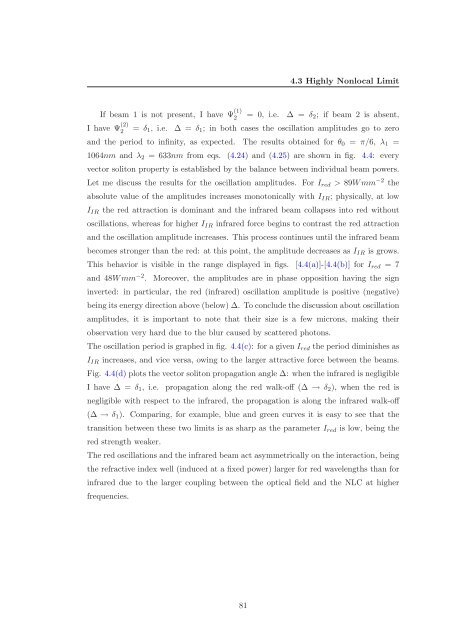Solitons in Nonlocal Media
Solitons in Nonlocal Media
Solitons in Nonlocal Media
Create successful ePaper yourself
Turn your PDF publications into a flip-book with our unique Google optimized e-Paper software.
4.3 Highly <strong>Nonlocal</strong> Limit<br />
If beam 1 is not present, I have Ψ (1)<br />
2 = 0, i.e. ∆ = δ2; if beam 2 is absent,<br />
I have Ψ (2)<br />
2 = δ1, i.e. ∆ = δ1; <strong>in</strong> both cases the oscillation amplitudes go to zero<br />
and the period to <strong>in</strong>f<strong>in</strong>ity, as expected. The results obta<strong>in</strong>ed for θ0 = π/6, λ1 =<br />
1064nm and λ2 = 633nm from eqs. (4.24) and (4.25) are shown <strong>in</strong> fig. 4.4: every<br />
vector soliton property is established by the balance between <strong>in</strong>dividual beam powers.<br />
Let me discuss the results for the oscillation amplitudes. For Ired > 89Wmm −2 the<br />
absolute value of the amplitudes <strong>in</strong>creases monotonically with IIR; physically, at low<br />
IIR the red attraction is dom<strong>in</strong>ant and the <strong>in</strong>frared beam collapses <strong>in</strong>to red without<br />
oscillations, whereas for higher IIR <strong>in</strong>frared force beg<strong>in</strong>s to contrast the red attraction<br />
and the oscillation amplitude <strong>in</strong>creases. This process cont<strong>in</strong>ues until the <strong>in</strong>frared beam<br />
becomes stronger than the red: at this po<strong>in</strong>t, the amplitude decreases as IIR is grows.<br />
This behavior is visible <strong>in</strong> the range displayed <strong>in</strong> figs. [4.4(a)]-[4.4(b)] for Ired = 7<br />
and 48Wmm −2 . Moreover, the amplitudes are <strong>in</strong> phase opposition hav<strong>in</strong>g the sign<br />
<strong>in</strong>verted: <strong>in</strong> particular, the red (<strong>in</strong>frared) oscillation amplitude is positive (negative)<br />
be<strong>in</strong>g its energy direction above (below) ∆. To conclude the discussion about oscillation<br />
amplitudes, it is important to note that their size is a few microns, mak<strong>in</strong>g their<br />
observation very hard due to the blur caused by scattered photons.<br />
The oscillation period is graphed <strong>in</strong> fig. 4.4(c): for a given Ired the period dim<strong>in</strong>ishes as<br />
IIR <strong>in</strong>creases, and vice versa, ow<strong>in</strong>g to the larger attractive force between the beams.<br />
Fig. 4.4(d) plots the vector soliton propagation angle ∆: when the <strong>in</strong>frared is negligible<br />
I have ∆ = δ1, i.e. propagation along the red walk-off (∆ → δ2), when the red is<br />
negligible with respect to the <strong>in</strong>frared, the propagation is along the <strong>in</strong>frared walk-off<br />
(∆ → δ1). Compar<strong>in</strong>g, for example, blue and green curves it is easy to see that the<br />
transition between these two limits is as sharp as the parameter Ired is low, be<strong>in</strong>g the<br />
red strength weaker.<br />
The red oscillations and the <strong>in</strong>frared beam act asymmetrically on the <strong>in</strong>teraction, be<strong>in</strong>g<br />
the refractive <strong>in</strong>dex well (<strong>in</strong>duced at a fixed power) larger for red wavelengths than for<br />
<strong>in</strong>frared due to the larger coupl<strong>in</strong>g between the optical field and the NLC at higher<br />
frequencies.<br />
81
















